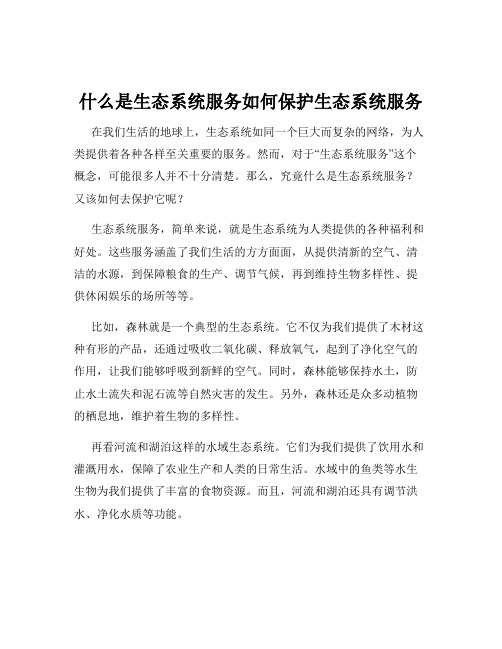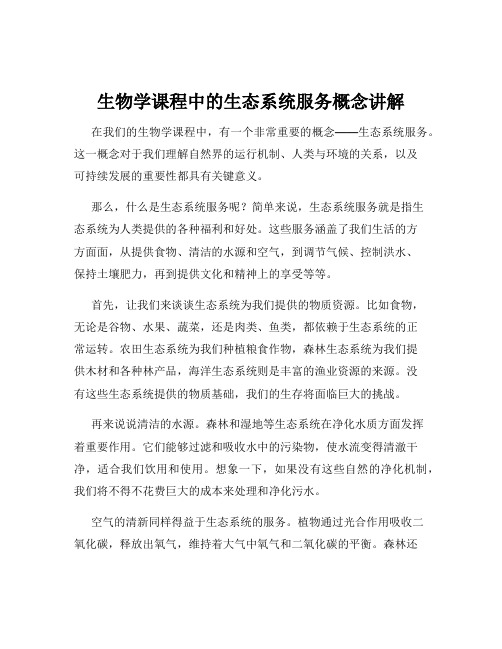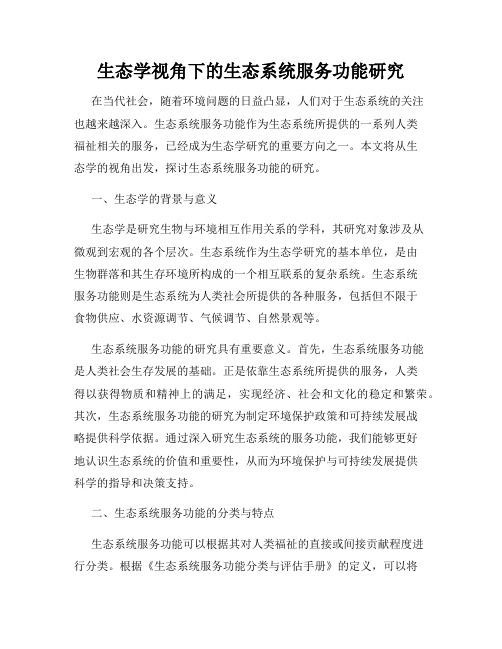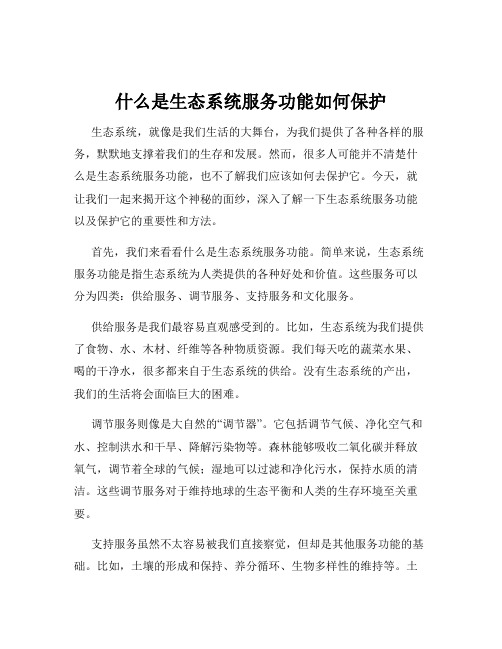“生态系统方法”与“生态系统服务”概念初探
生态系统服务和生态系统功能

XX,a click to unlimited possibilities
汇报人:XX
目录 /目录
01
点击此处添加 目录标题
04
生态系统服务 和生态系统功 能的联系
02
生态系统服务
05
案例分析
03
生态系统功能
06
未来展望
01 添加章节标题
02 生态系统服务
定义和分类
提供资源: 生态系统服 务为人类提 供食物、木 材、药材等 资源,满足 人类生活需 求。
审美价值: 生态系统服 务提供美丽 的自然景观, 为人类提供 审美享受和 精神寄托。
生态系统服务的价值评估
生态系统服务的定义和分类 生态系统服务的价值评估方法 生态系统服务的价值评估案例 生态系统服务的价值评估在政策制定中的应用
生态系统服务的管理和保护
生态系统服务的重要性:为人类提供生存和发展所需的环境条件
生态系统服务的管理:制定相关政策和法规,加强生态监测和评估
生态系统服务的保护:采取措施减少人类活动对生态系统的破坏,保护生物多样性和 生态环境
生态系统服务的可持续利用:合理利用生态系统服务,实现经济、社会和环境的协调发展
生态系统服务的重要性
维持生物多 样性:生态 系统服务为 各种生物提 供生存空间 和食物来源, 有助于保持 生物多样性。
调节气候: 生态系统服 务通过光合 作用、蒸腾 作用等过程, 调节气候, 保持地球温 度稳定。
净化环境: 生态系统服 务通过生物 降解、过滤 等过程,净 化空气、水 质,减少污 染。
城市废弃物处理: 回收利用废弃物, 减少环境污染
农业生态系统服务和功能
农业生态系统的定 义和特点
“生态系统方法”与“生态系统服务”概念初探

Ecosystem Approach 生态系统方法
• Meant basicly for governments under CBD-implementation. Focus on the highest level of biodiversity 主要针对政府履行 《生物多样性公约》(生多公约),关注生物多样性的最高层 次 • Industry/economic sectors may contribute greatly to ‖implementation‖ 工业(经济)部门可以对“执行”贡献巨 大 • No blueprint for all situations 没有针对所有情况的蓝图计划 • Preconditions and various success-factors for each principle 每条原则的前提条件和各种成功因素 • Specific ‖Integrated Resource Management Procedures‖ (IRMPs) in various biomes/ecosystems? 各种生物群落(生 态系统)特有的“综合资源管理程序” (IRMPs) ?
• A conceptual link between the concepts 各概念之间的概念 性联系 • Key aspects of biodiversity management can be developed 生物多样性管理的重要方面都得到发展 • Trade-off challenges arise between various services 需要在不同服务之间进行权衡所带来的挑战 • New methodologies are needed, both for valuation and trade-off procedures 需要经济价值评估与权衡程序的新方 法论 • Multilevel perspective important, but policy conflicts between administrative levels may occur 多层面的视角很 重要,但是有可能发生行政层级之间的政策冲突
生态系统功能与生态系统服务的概念辨析

生态系统功能与生态系统服务的概念辨析冯剑丰;李宇;朱琳【期刊名称】《生态环境学报》【年(卷),期】2009(018)004【摘要】"生态系统功能(Ecosystem functions)"和"生态系统服务(Ecosystem services)"已成为生态学中的重要研究领域.针对国内部分研究人员对"生态系统功能"与"生态系统服务(功能)"概念和术语混淆使用的问题,在归纳总结国内外有关的重要研究的基础上,通过分别论述"生态系统功能"与"生态系统服务"的定义和内涵,辨析和阐明了生态系统"功能"与"服务"的区别与关系.生态系统功能是构建系统内生物有机体生理功能的过程,侧重于反映生态系统的自然属性,是维持生态系统服务的基础;生态系统服务是由生态系统功能产生的,是基于人类的需要、利用和偏好,反映了人类对生态系统功能的利用,是生态系统功能满足人类福利的一种表现.因此"生态系统服务功能"这一术语不准确,容易产生误解.【总页数】5页(P1599-1603)【作者】冯剑丰;李宇;朱琳【作者单位】南开大学环境科学与工程学院//环境污染过程与基准教育部重点实验室,天津,300071;南开大学环境科学与工程学院//环境污染过程与基准教育部重点实验室,天津,300071;南开大学环境科学与工程学院//环境污染过程与基准教育部重点实验室,天津,300071【正文语种】中文【中图分类】Q147【相关文献】1.生态健康、生态风险、生态安全概念辨析 [J], 边得会;曹勇宏;何春光;高昆2.生态系统的服务功能Ⅰ生态系统服务的概念与特性 [J], 周兴民3.自觉的生态文学与自发的生态文学——生态文学概念辨析 [J], 王惠4.生态资产核算与生态系统服务评估:概念交汇与重点方向 [J], 刘焱序;傅伯杰;赵文武;王帅5."生态系统服务"与"环境服务"法律概念辨析 [J], 高敏因版权原因,仅展示原文概要,查看原文内容请购买。
关于“生态系统服务”之辨析与思考

关于“生态系统服务”之辨析与思考作者:王野林来源:《现代企业文化·理论版》2011年第18期生态系统服务及其生命支持系统服务生态系统服务(Ecosystem services)是指人类直接或间接从生态系统与生态过程得到的所有惠益,由MA(一个关于生态评估的国际合作项目)工作组提出的生态系统服务分类方法(MAG,2002)将生态系统服务功能类型归纳为四个方面,包括产品提供功能——提供能为人类带来直接利益的各类自然资源相关产品,如粮食、水源等;调节功能——调节人类生态环境的生态系统服务的功能;如净化环境、调节气候;文化功能——生态系统中所提供的各类精神、美学、娱乐和文化的享受及惠益;支持功能——维持地球生态整体存在的功能,如维持地球生命生存环境的养分循环。
这是保证其它所有生态系统服务功能提供所必需的基础功能。
对于生态系统服务的分类,还有其它分法,但不管在理解上有何差异,人们都强调生态系统服务的核心是其生命支持系统服务,其实,现在多数人是在广义上,即把生态系统的调节功能与支持功能结合起来,来理解生命支持体统服务。
生态系统服务概念的提出及其在生态系统服务分类方面的研究成果,为生态系统服务价值评价提供了基础,目前专业领域已有能值分析评价法、物质量评价法、价值量评价方法等多种计量价值评估方法。
美国康斯坦扎(Costanza)等人(1997)关于全球生态系统服务与自然资本价值估算的研究工作算出,全球生态系统服务每年的总价值约为为16~54万亿美元,平均为33万亿美元,而这相当于1997年全球GNP的1.8倍,这是全球生态系统服务价值评估的典型一例。
总之,关于生态系统服务与自然资本价值估算的多方面研究工作,进一步推动和促进了关于生态系统服务的深入、系统的研究。
生态系统服务的公共物品属性与外部性首先,分析一下生态系统服务的构成就可看出其在公共物品属性上表现出复杂性,不可一概而论。
所谓公共物品是指公共使用或消费的物品,是可以供社会成员共同享用的物品,生态系统服务的主要部分就具有很强的公共物品属性;严格意义上的公共物品首先是具有非竞争性,这是指某人对公共物品的消费并不会影响别人同时消费该产品及其从中获得的效用,如森林生态系统服务提供的新鲜的空气;其次是具有非排他性,这是指某人在消费一种公共物品时,不能排除其他人消费这一物品(不论他们是否付费,例如国防安全、良好的自然景观)。
什么是生态系统服务如何保护生态系统服务

什么是生态系统服务如何保护生态系统服务在我们生活的地球上,生态系统如同一个巨大而复杂的网络,为人类提供着各种各样至关重要的服务。
然而,对于“生态系统服务”这个概念,可能很多人并不十分清楚。
那么,究竟什么是生态系统服务?又该如何去保护它呢?生态系统服务,简单来说,就是生态系统为人类提供的各种福利和好处。
这些服务涵盖了我们生活的方方面面,从提供清新的空气、清洁的水源,到保障粮食的生产、调节气候,再到维持生物多样性、提供休闲娱乐的场所等等。
比如,森林就是一个典型的生态系统。
它不仅为我们提供了木材这种有形的产品,还通过吸收二氧化碳、释放氧气,起到了净化空气的作用,让我们能够呼吸到新鲜的空气。
同时,森林能够保持水土,防止水土流失和泥石流等自然灾害的发生。
另外,森林还是众多动植物的栖息地,维护着生物的多样性。
再看河流和湖泊这样的水域生态系统。
它们为我们提供了饮用水和灌溉用水,保障了农业生产和人类的日常生活。
水域中的鱼类等水生生物为我们提供了丰富的食物资源。
而且,河流和湖泊还具有调节洪水、净化水质等功能。
生态系统服务的重要性不言而喻。
然而,在当今社会,由于人类活动的不断加剧,生态系统面临着前所未有的威胁,生态系统服务也受到了严重的影响。
城市化进程的加速导致大量的土地被开发和占用,森林、湿地等自然生态系统遭到破坏。
工业生产和交通运输排放出大量的污染物,使得空气质量下降,水资源受到污染。
过度的农业开垦和放牧导致土地退化,土壤肥力下降。
此外,非法的采伐、狩猎和捕捞等活动也对生态系统造成了极大的破坏,威胁着生物多样性。
那么,我们应该如何保护生态系统服务呢?首先,加强环境保护意识的教育至关重要。
通过教育,让人们认识到生态系统服务的重要性,了解人类活动对生态系统的影响,从而树立起保护环境的责任感和使命感。
这可以通过学校教育、社区宣传、媒体报道等多种途径来实现。
其次,制定和完善相关的法律法规也是必不可少的。
政府应当出台严格的环境保护法律,对破坏生态环境的行为进行严厉的惩罚。
什么是生态系统服务如何保护生态系统

什么是生态系统服务如何保护生态系统在我们生活的地球上,生态系统就如同一个巨大而复杂的网络,为我们提供着各种各样至关重要的服务。
然而,对于很多人来说,“生态系统服务”这个概念可能还比较陌生。
那么,究竟什么是生态系统服务呢?又该如何去保护我们赖以生存的生态系统呢?简单来说,生态系统服务指的是人类从生态系统中获得的各种益处。
这些服务涵盖了我们生活的方方面面,从提供清新的空气、清洁的水源,到为我们供应丰富的食物,再到调节气候、防止水土流失等等。
比如说,森林生态系统能够吸收二氧化碳并释放氧气,这对于维持大气中的气体平衡以及保障我们能够呼吸到新鲜的空气至关重要。
同时,森林还能够调节局部气候,使得周边地区的气温更加宜人,降水更加均衡。
河流、湖泊等水域生态系统为我们提供了清洁的水资源。
这些水资源不仅用于我们的日常生活,如饮用、洗漱、灌溉等,还支撑着工业生产和农业发展。
此外,水域生态系统中的水生生物也是人类重要的食物来源之一。
农田生态系统则为我们源源不断地生产着粮食、蔬菜和水果,满足了我们的基本生存需求。
生态系统服务还包括了土壤的形成和保持。
健康的土壤能够支持植物生长,为农业生产提供基础,同时也能够过滤和储存水分,防止洪涝灾害的发生。
然而,如今我们的生态系统正面临着诸多威胁。
人类活动的不断扩张,如过度开垦、过度放牧、滥砍滥伐等,导致了生态系统的破坏和退化。
工业污染、农业面源污染等也使得生态环境质量下降,影响了生态系统服务的正常供给。
那么,我们应该如何保护生态系统,以确保这些宝贵的服务能够持续为我们所用呢?首先,我们需要树立正确的生态观念。
认识到生态系统对于人类生存和发展的重要性,摒弃那种只追求短期经济利益而忽视生态保护的错误观念。
每个人都应该从自身做起,增强环保意识,在日常生活中采取节约资源、减少浪费的行动。
在政策层面,政府应当制定和完善相关的法律法规,加强对生态环境的保护和监管。
对于破坏生态环境的行为,要给予严厉的惩罚。
生物学课程中的生态系统服务概念讲解

生物学课程中的生态系统服务概念讲解在我们的生物学课程中,有一个非常重要的概念——生态系统服务。
这一概念对于我们理解自然界的运行机制、人类与环境的关系,以及可持续发展的重要性都具有关键意义。
那么,什么是生态系统服务呢?简单来说,生态系统服务就是指生态系统为人类提供的各种福利和好处。
这些服务涵盖了我们生活的方方面面,从提供食物、清洁的水源和空气,到调节气候、控制洪水、保持土壤肥力,再到提供文化和精神上的享受等等。
首先,让我们来谈谈生态系统为我们提供的物质资源。
比如食物,无论是谷物、水果、蔬菜,还是肉类、鱼类,都依赖于生态系统的正常运转。
农田生态系统为我们种植粮食作物,森林生态系统为我们提供木材和各种林产品,海洋生态系统则是丰富的渔业资源的来源。
没有这些生态系统提供的物质基础,我们的生存将面临巨大的挑战。
再来说说清洁的水源。
森林和湿地等生态系统在净化水质方面发挥着重要作用。
它们能够过滤和吸收水中的污染物,使水流变得清澈干净,适合我们饮用和使用。
想象一下,如果没有这些自然的净化机制,我们将不得不花费巨大的成本来处理和净化污水。
空气的清新同样得益于生态系统的服务。
植物通过光合作用吸收二氧化碳,释放出氧气,维持着大气中氧气和二氧化碳的平衡。
森林还能够吸附空气中的灰尘和有害气体,改善空气质量。
在城市中,树木和绿地的存在对于减轻空气污染、提高居民的生活质量至关重要。
生态系统在调节气候方面也有着不可替代的作用。
森林可以调节气温和湿度,减少极端气候的发生。
大面积的森林能够吸收大量的太阳能,降低地表温度,而在冬季又能起到一定的保温作用。
海洋生态系统也对全球气候有着重要影响,海洋的流动和热量交换影响着气候的分布和变化。
控制洪水是生态系统服务的另一个重要方面。
河流沿岸的湿地和森林能够吸收和储存大量的水分,减缓洪水的流速和流量,降低洪水造成的损失。
当我们过度开发湿地和砍伐森林时,洪水的危害往往会加剧。
土壤肥力的保持也离不开生态系统。
什么是生态系统服务如何维护生态系统

什么是生态系统服务如何维护生态系统在我们生活的这个地球上,生态系统就如同一个巨大而复杂的机器,默默地为我们提供着各种各样至关重要的服务。
然而,很多人可能并不清楚什么是生态系统服务,也不了解我们应该如何去维护这个珍贵的系统。
接下来,让我们一起深入探讨这个与我们的生存和未来息息相关的重要话题。
生态系统服务,简单来说,就是大自然为人类提供的各种好处和支持。
它涵盖了多个方面,从我们呼吸的空气、饮用的水,到我们食用的食物,以及享受的美丽风景和宁静环境,都离不开生态系统的服务。
首先,生态系统为我们提供了清新的空气。
通过植物的光合作用,吸收二氧化碳,释放出氧气,维持着大气中气体的平衡,让我们能够自由地呼吸。
想象一下,如果没有森林和植被来进行这样的气体交换,我们所生活的环境将会变得多么糟糕。
其次,清洁的水源也是生态系统服务的重要一环。
森林和湿地能够过滤和净化水流,减少污染物的含量。
河流、湖泊和地下水系统为我们提供了生活用水、农业灌溉用水和工业用水。
如果生态系统遭到破坏,水源受到污染,我们的健康和生活将面临巨大的威胁。
食物的供应同样依赖于生态系统。
农田生态系统为我们生产出丰富的粮食、蔬菜和水果。
而森林中的野生动植物也为我们提供了各种食物资源。
此外,渔业依赖于海洋和淡水生态系统中的鱼类资源。
没有健康的生态系统,我们的餐桌将会变得十分单调,甚至面临食物短缺的危机。
生态系统还具有调节气候的作用。
大面积的森林能够吸收热量,降低气温,增加空气湿度,从而减轻极端天气的影响。
湿地能够储存大量的水分,在洪水来临时起到缓冲作用,减少洪涝灾害的发生。
除了物质方面的服务,生态系统还为我们提供了精神和文化上的价值。
美丽的自然景观让我们感到身心愉悦,给我们带来心灵的慰藉和放松。
许多地方的传统文化和宗教信仰都与当地的生态系统紧密相连,成为了人类文化遗产的一部分。
既然生态系统服务对我们如此重要,那么我们应该如何维护这个宝贵的系统呢?首先,我们需要保护和恢复生态系统的多样性。
什么是生态系统服务如何维护生态系统服务

什么是生态系统服务如何维护生态系统服务在我们生活的这个地球上,生态系统就像是一个复杂而又精妙的大机器,默默地为我们提供着各种各样不可或缺的服务。
但你是否真正了解什么是生态系统服务?又是否清楚我们应该如何去维护它呢?生态系统服务,简单来说,就是大自然为人类提供的各种好处。
它涵盖了我们生活的方方面面,从我们呼吸的空气,到饮用的水,再到我们所食用的食物,无一不是生态系统服务的成果。
首先,生态系统为我们提供了清洁的空气。
植物通过光合作用吸收二氧化碳,并释放出氧气,维持了大气中氧气和二氧化碳的平衡,让我们能够畅快地呼吸。
想象一下,如果没有这个服务,我们的生存将会变得多么艰难。
其次,它为我们提供了干净的水资源。
森林和湿地能够过滤和净化水流,使得地表水和地下水保持适宜人类使用的质量和数量。
再者,生态系统还为我们提供了丰富的食物资源。
无论是田野里的庄稼,还是江河湖海中的鱼虾贝类,都是生态系统的馈赠。
除了这些物质层面的服务,生态系统还在精神和文化方面给我们带来了益处。
美丽的自然景观能够舒缓我们的心情,减轻压力,激发我们的创造力和想象力。
许多地方的传统文化和宗教信仰也都与当地的生态系统紧密相连。
然而,随着人类活动的不断加剧,生态系统服务正面临着严峻的挑战。
过度的砍伐森林、开垦荒地、过度捕捞以及大规模的工业排放等行为,都在破坏着生态平衡,削弱着生态系统为我们提供服务的能力。
那么,我们应该如何维护生态系统服务呢?首先,要加强对生态系统的保护。
建立自然保护区,划定生态红线,限制开发活动,保护野生动植物的栖息地,让它们能够在自然的环境中繁衍生息。
其次,推动可持续的土地利用和水资源管理。
合理规划城市和农业用地,避免过度开发和浪费。
采用科学的灌溉和耕作方式,减少水土流失和水资源污染。
再者,倡导绿色消费和低碳生活方式。
我们在日常生活中可以减少一次性用品的使用,选择环保的交通工具,节约水电等资源。
此外,加强环境教育也至关重要。
让每个人都了解生态系统服务的重要性,提高环保意识,形成全社会共同保护生态环境的良好氛围。
生态系统服务的概念

生态系统服务的概念生态系统服务的概念一、引言生态系统服务是指自然系统为人类提供的各种物质和非物质的利益,包括食品、水源、气候调节、土壤保持、药品等。
生态系统服务是人类生存和发展的基础,也是维持生态平衡和可持续发展的重要保障。
二、概念界定1. 生态系统服务的定义生态系统服务(Ecosystem Services)是指自然系统为人类提供的各种物质和非物质的利益,包括食品、水源、气候调节、土壤保持、药品等。
2. 生态系统服务的分类根据其提供的功能和价值,可以将生态系统服务分为四类:支持性服务(Supporting Services)、调节性服务(Regulating Services)、供给性服务(Provisioning Services)和文化性服务(Cultural Services)。
3. 生态系统服务的特点生态系统服务具有以下特点:(1)多样性:不同类型的自然环境提供不同类型的生态系统服务;(2)互联性:各种生态系统服务相互依存,相互影响;(3)动态性:随着环境变化和人类活动影响,生态系统服务也会发生变化;(4)地域性:生态系统服务的类型和价值在不同地区有所差异。
三、生态系统服务的作用1. 维持生态平衡生态系统服务是维持生态平衡的重要保障。
例如,森林可以吸收二氧化碳,缓解气候变化;湿地可以净化水质,维护水资源;草原可以保持土壤不被侵蚀,防止沙漠化等。
2. 支撑人类生存和发展生态系统服务为人类提供了食品、水源、药品等物质和文化遗产等非物质利益,是人类生存和发展的基础。
3. 促进经济发展许多行业如农业、渔业、林业、旅游业等都依赖于生态系统服务。
因此,保护和恢复生态系统服务不仅对环境有益,也对经济有重要意义。
四、影响生态系统服务的因素1. 气候变化气候变化会影响自然环境,导致一些物种灭绝或迁徙,从而影响到生态系统服务的提供。
2. 土地利用变化人类活动对土地的利用会直接影响到生态系统服务的提供。
例如,过度开垦土地、城市化等都会破坏生态系统。
生态学视角下的生态系统服务功能研究

生态学视角下的生态系统服务功能研究在当代社会,随着环境问题的日益凸显,人们对于生态系统的关注也越来越深入。
生态系统服务功能作为生态系统所提供的一系列人类福祉相关的服务,已经成为生态学研究的重要方向之一。
本文将从生态学的视角出发,探讨生态系统服务功能的研究。
一、生态学的背景与意义生态学是研究生物与环境相互作用关系的学科,其研究对象涉及从微观到宏观的各个层次。
生态系统作为生态学研究的基本单位,是由生物群落和其生存环境所构成的一个相互联系的复杂系统。
生态系统服务功能则是生态系统为人类社会所提供的各种服务,包括但不限于食物供应、水资源调节、气候调节、自然景观等。
生态系统服务功能的研究具有重要意义。
首先,生态系统服务功能是人类社会生存发展的基础。
正是依靠生态系统所提供的服务,人类得以获得物质和精神上的满足,实现经济、社会和文化的稳定和繁荣。
其次,生态系统服务功能的研究为制定环境保护政策和可持续发展战略提供科学依据。
通过深入研究生态系统的服务功能,我们能够更好地认识生态系统的价值和重要性,从而为环境保护与可持续发展提供科学的指导和决策支持。
二、生态系统服务功能的分类与特点生态系统服务功能可以根据其对人类福祉的直接或间接贡献程度进行分类。
根据《生态系统服务功能分类与评估手册》的定义,可以将生态系统服务功能分为四类:供给服务、调节服务、文化服务和支持服务。
1. 供给服务供给服务是指生态系统为人类提供直接利用的物质和能量资源,如食物、水资源、木材等。
这些服务直接满足人类的基本生活需求,是生态系统功能的直接体现。
2. 调节服务调节服务是指生态系统对环境的调节作用,包括气候调节、水资源调节和自然灾害的缓解等。
这些服务直接或间接影响到人类社会的生产和生活,具有重要的经济和社会价值。
3. 文化服务文化服务是指生态系统所提供的对人类文化和精神生活的支持,包括自然景观、休闲娱乐、教育等。
这些服务对人类精神的满足和文化的繁荣具有重要意义。
生态学中的生态系统服务研究

生态学中的生态系统服务研究随着人们对环境保护意识的日益提高,生态学已经成为了一个备受人们关注的领域。
生态系统服务研究是生态学中一个非常重要的分支,它研究的是人类利用自然资源所获得的经济、社会和环境价值。
生态系统指的是一个生物群落与其所在的环境之间互相作用、互相影响的系统。
不同的生态系统包含了不同的物种,其提供的生态系统服务也是不同的。
例如森林生态系统可以提供木材、水源保护以及适宜的生态旅游环境等等;河流生态系统则提供了水源和生物栖息地等服务。
生态系统服务研究的目的是提高人们对生态系统服务价值的认识和利用情况的改进。
为此,生态系统研究者会通过生态系统的结构、物种组成、功能等多个方面来评估生态系统服务。
其中,生态系统服务分为四种类型:支持性生态系统服务、调节性生态系统服务、供给性生态系统服务和文化性生态系统服务。
支持性生态系统服务是指生态系统提供的物质和能量来源,例如养分循环、土地形成等。
调节性生态系统服务指生态系统通过控制气候、水质、洪水等来保持人类和其他生物群落的生存环境。
供给性生态系统服务则是指人类能够直接利用的生态系统产品和资源,如木材、水资源、食品等。
文化性生态系统服务则为人类提供了一种心理上的、符号化的服务,如精神满足、创造力的激发等。
为了更好地利用生态系统服务的优势,我们需要对生态系统服务价值进行评估。
生态系统服务价值有三种方法:经济评估、群众参与评估和生态演替模型。
其中,经济评估法是计算这些服务的经济收益,以展示服务的价值。
群众参与评估法是通过向当地居民、游客等征询对景观、文化和自然资源影响的看法来评估生态系统服务价值。
而生态演替模型则是一种模拟技术,通过运用一组物理和生态方程来预测和分析生态系统变化的过程。
生态系统服务研究在今天的环保事业中扮演着至关重要的角色。
它可以帮助我们了解自然界的运行方式并促进可持续利用自然资源的方法。
另外,生态系统服务还可以帮助旅游业、水资源管理、林业管理等多个领域做出科学决策,以避免长期的环境影响。
什么是生态系统服务功能如何保护

什么是生态系统服务功能如何保护生态系统,就像是我们生活的大舞台,为我们提供了各种各样的服务,默默地支撑着我们的生存和发展。
然而,很多人可能并不清楚什么是生态系统服务功能,也不了解我们应该如何去保护它。
今天,就让我们一起来揭开这个神秘的面纱,深入了解一下生态系统服务功能以及保护它的重要性和方法。
首先,我们来看看什么是生态系统服务功能。
简单来说,生态系统服务功能是指生态系统为人类提供的各种好处和价值。
这些服务可以分为四类:供给服务、调节服务、支持服务和文化服务。
供给服务是我们最容易直观感受到的。
比如,生态系统为我们提供了食物、水、木材、纤维等各种物质资源。
我们每天吃的蔬菜水果、喝的干净水,很多都来自于生态系统的供给。
没有生态系统的产出,我们的生活将会面临巨大的困难。
调节服务则像是大自然的“调节器”。
它包括调节气候、净化空气和水、控制洪水和干旱、降解污染物等。
森林能够吸收二氧化碳并释放氧气,调节着全球的气候;湿地可以过滤和净化污水,保持水质的清洁。
这些调节服务对于维持地球的生态平衡和人类的生存环境至关重要。
支持服务虽然不太容易被我们直接察觉,但却是其他服务功能的基础。
比如,土壤的形成和保持、养分循环、生物多样性的维持等。
土壤为植物提供了生长的基础,生物多样性保证了生态系统的稳定和适应能力。
文化服务则赋予了我们精神上的享受和满足。
美丽的自然风光可以激发我们的创造力和想象力,成为艺术和文学的灵感源泉。
生态系统还为我们提供了休闲、娱乐和旅游的场所,让我们能够放松身心,感受大自然的魅力。
了解了生态系统服务功能的种类,接下来我们要思考的是如何保护这些宝贵的服务。
保护生态系统服务功能,首先要从保护生态系统的完整性入手。
这意味着我们要保护各种生态系统,如森林、草原、湿地、河流、海洋等,减少对它们的破坏和干扰。
我们不能随意砍伐森林、开垦草原、填埋湿地,要尊重它们的自然规律和生态过程。
合理利用资源也是保护的关键。
在获取生态系统提供的资源时,我们要遵循可持续的原则,不能过度开发和滥用。
什么是生态系统服务如何保护生态系统

什么是生态系统服务如何保护生态系统在我们生活的这个地球上,生态系统就像是一个巨大的、复杂而又精密的机器,为我们提供着各种各样不可或缺的服务。
那么,究竟什么是生态系统服务?又该如何保护这个对我们至关重要的生态系统呢?生态系统服务,简单来说,就是生态系统为人类提供的各种好处和利益。
它涵盖了多个方面,从我们呼吸的清新空气,到饮用的干净水源;从滋养土地的肥沃土壤,到丰富多样的食物供应;从调节气候,到抵御自然灾害等等。
首先,生态系统为我们提供了清新的空气。
植物通过光合作用吸收二氧化碳,释放出氧气,这是我们生存所必需的。
森林就像是地球上的“绿肺”,不断地净化着空气。
想象一下,如果没有这些绿色的植物,空气中的氧气会变得稀缺,而二氧化碳等有害气体则会大量积聚,我们的呼吸将变得困难,健康也会受到严重威胁。
干净的水源也是生态系统给予我们的重要服务之一。
河流、湖泊、地下水等水源,在经过生态系统的过滤和净化后,成为了我们可以使用的清洁水。
湿地就像是天然的净水器,能够去除水中的污染物和杂质。
如果生态系统遭到破坏,水源可能会受到污染,导致水资源短缺和水质恶化,这将对我们的生活和农业生产造成极大的困扰。
肥沃的土壤同样是生态系统服务的一部分。
土壤中的微生物和有机物分解着废弃物,为植物提供养分。
森林和草原能够防止水土流失,保持土壤的肥力。
然而,过度的开垦和不合理的农业活动可能会导致土壤贫瘠、沙漠化,影响农作物的生长和粮食的产量。
食物的供应更是生态系统服务的直接体现。
从农田里的庄稼,到果园中的水果,再到海洋中的鱼类,生态系统为我们提供了丰富多样的食物来源。
如果生态系统失衡,生物多样性减少,我们的食物选择将会变得有限,甚至可能面临粮食安全的问题。
此外,生态系统在调节气候方面也发挥着关键作用。
森林可以吸收大量的热量,降低气温;海洋能够储存和释放热量,影响全球的气候模式。
而生态系统的破坏,如森林砍伐和温室气体排放的增加,会导致气候变化加剧,极端天气频繁出现,给人类带来巨大的灾害和损失。
“生态系统方法”与“生态系统服务”概念初探共23页

“生态系统方法”与“生态系统服务”概 念初探
31、园日涉以成趣,门虽设而常关。 32、鼓腹无所思。朝起暮归眠。 33、倾壶绝余沥,窥灶不见烟。
34、春5、丈夫志四海,我愿不知老。
谢谢你的阅读
❖ 知识就是财富 ❖ 丰富你的人生
“生态系统方法”与“生态系统服务”概念初探PPT共23页

END
“生态系统方法”与“生态系 统服务”概念初探
11、战争满足了,或曾经满足过人的 好斗的 本能, 但它同 时还满 足了人 对掠夺 ,破坏 以及残 酷的纪 律和专 制力的 欲望。 ——查·埃利奥 特 12、不应把纪律仅仅看成教育的手段 。纪律 是教育 过程的 结果, 首先是 学生集 体表现 在一切 生活领 域—— 生产、 日常生 活、学 校、文 化等领 域中努 力的结 果。— —马卡 连柯(名 言网)
13、遵守纪律的风气的培养,只有领 导者本 身在这 方面以 身作则 才能收 到成效 。—— 马卡连 柯 14、劳动者的组织性、纪律性、坚毅 精神以 及同全 世界劳 动者的 团结一 致,是 取得最 后胜利 的保证 。—— 列宁 摘自名言网
15、机会是不守纪律的。——雨果
16、业余生活要有意义,不要越轨。——华盛顿 17、一个人即使已登上顶峰,也仍要自强不息。——罗素·贝克 18、最大的挑战和突破在于着,就是为了使别人过得更美好。——雷锋 20、要掌握书,莫被书掌握;要为生而读,莫为读而生。——布尔沃
“生态系统方法”与“生态系统服务”概念初探

Sino-Norwegian Competence Building Project on Environmental Management 2011 - Biodiversity Training Program
全球生物多样性评估
InterGovernmental Science-Policy Platform for Biodiversity and Ecosystems (IPBES) 千年生态系统评估 生物多样性和生态系统服务 政府间科学政策平台(IPBES)
•
• • • •+/– •+/–
•wood fuel 木材燃料
•Genetic resources 遗传资源 •Biochemicals, medicines 生物化学制品、药品 • Fresh water 淡水
•
• • •
Sino-Norwegian Competence Building Project on Environmental Management 2011 - Biodiversity Training Program
• • • •+/– • • •+/– • •
•Water regulation 调节水资源 •Erosion regulation 调节水土流失
•Water purification and waste treatment 净化水质和处理污物
•Disease regulation 疾病调节 •Pest regulation 调节病虫害 •Pollination授粉
•Natural hazard regulation 调节自然灾害
•
• • •+/–
•Cultural Services文化服务
生态系统服务生态学的概念和方法研究

生态系统服务生态学的概念和方法研究生态系统服务生态学,简称ES(Ecosystem Services)生态学,是近年来生态学研究的热点之一。
其核心观点是,人类社会依赖于生态系统可以提供的诸多生态系统服务而生存和发展,因此需要认识、评价、保持和利用生态系统服务,以维护生态系统的完整和稳定。
一、ES生态学概述生态系统服务(Ecosystem Services,ES)是指生态系统所提供的直接或间接满足人类需求的各种物质和非物质产品和服务。
ES生态学是通过研究生态系统的结构和功能,探讨其中所涉及的生态服务,以及与此相关的人类利益和影响的学科。
生态系统服务生态学研究的是人与自然的“协同作用”,并致力于探寻人类活动对自然生态系统产生的影响,以及如何保护和使用生态系统服务,以促进人与自然的和谐发展。
二、ES生态学的基本原理与观点1. 生态系统中,各种生物、物理、化学要素之间相互联系,共同维持着生态系统的基本结构和功能,从而提供了多样的生态系统服务。
2. 生态系统服务的提供和利用对人类的生存和发展至关重要,而“保护生态系统,利用生态系统”是实现可持续发展的重要途径。
3. 生态系统服务的提供和利用通常受到生态系统健康和完整性的保障,因此需要对生态系统进行保护和管理。
三、ES生态学的研究对象和方法1. 生态系统服务的研究对象:生态系统提供的各种直接、间接生态系统服务,如食品、水源、气候调节、生物多样性保护等。
2. ES生态学的研究方法:(1)资料收集,包括文献、资料、专家意见等,系统评价生态系统服务。
(2)观测和实验,研究生态系统结构、功能和生态系统服务的关系。
(3)数学模型和GIS技术,对生态系统服务进行空间分析和定量评估。
(4)生态系统服务估价方法,评估生态系统服务的价值。
四、ES生态学的应用前景1. 生态经济、生态农业和生态旅游等领域可获益于对生态系统服务的定量估价和保护管理。
2. 城市生态系统管理和生态环境评估中,生态系统服务估价可为相关决策提供科学依据。
- 1、下载文档前请自行甄别文档内容的完整性,平台不提供额外的编辑、内容补充、找答案等附加服务。
- 2、"仅部分预览"的文档,不可在线预览部分如存在完整性等问题,可反馈申请退款(可完整预览的文档不适用该条件!)。
- 3、如文档侵犯您的权益,请联系客服反馈,我们会尽快为您处理(人工客服工作时间:9:00-18:30)。
(INTEGRATED) ECOSYSTEM APPROACH (EA) (综合)生态系统方法(EA)
1. Management objectives are a matter of societal choice 管理目标是社会的选择 2. Management should be decentralised to the lowest appropriate level 管理应该下放 到恰当的最低层级 3. Consider the effects on other areas/ecosystems 考虑对其他领域或生态系统的影响 4. Ecosystem management must be understood in a socio-economic context 必须在 社会经济环境中理解生态系统管理 5. Conservation of ecosystem functioning is crucial 保护生态系统功能尤为重要 6. Management should be undertaken at the appropriate scale (related to problem/challenge) 应该在合适的范围和尺度内进行管理(与问题和挑战相关) 7. Set long term goals and beware of lag effects 制定长期目标,了解阻碍目标实现 的因素 8. Beware of cyclic and other changes 了解循环变化和其他的变化 9. Manage within the limits to system(s) functioning 在系统功能的限制范围内进行管理 10. Find balance between conservation and sustainable use 在保护与可持续利用之 间寻找平衡 11. Use all relevant information 使用所有相关信息 12. Involve all relevant sectors/stakeholders/disciplines 将所有相关部门、利益相关方 和领域都纳入进来
Provisioningops 粮食作物
•livestock 家畜
•capture fisheries捕捞渔业 •aquaculture 养殖渔业 •wild foods 野生食物 •Fiber 纤维 •timber 木材 •cotton, silk 棉花,丝绸
Basic thinking 基本思想
• Those who have the benefits, should bear the costs, and those who have costs without benefits, should be compensated 谁获益谁负担成本,那些没有获益却负担 了成本的应该获得补偿。 • There are often trade-offs! Methods for optimal trade-offs must be developed 总会存在权衡现象!需要开发能得到 最佳权衡结果的方法。 • Valuation methodology is still deficient and must be much improved 经济评价方法仍然不够有效,需要进一 步改进。 • ES is more difficult to apply over multiple levels. How can we capture global values at the national and local level? 生态系统服务方法很难在多层面上应用。如何在 地方和国家层面上获得全球的价值?
全球生物多样性评估
InterGovernmental Science-Policy Platform for Biodiversity and Ecosystems (IPBES) 千年生态系统评估 生物多样性和生态系统服务 政府间科学政策平台(IPBES)
•Service服务
•Status现状 •
Ecosystem approach/Ecosystem services 生态系统方法和生态系统服务
• A conceptual link between the concepts 各概念之间的概念 性联系 • Key aspects of biodiversity management can be developed 生物多样性管理的重要方面都得到发展 • Trade-off challenges arise between various services 需要在不同服务之间进行权衡所带来的挑战 • New methodologies are needed, both for valuation and trade-off procedures 需要经济价值评估与权衡程序的新方 法论 • Multilevel perspective important, but policy conflicts between administrative levels may occur 多层面的视角很 重要,但是有可能发生行政层级之间的政策冲突
Challenges with the ES-concept 生态系统服务概念面临的挑战
• Can biodiversity and all nature elements and functions be valued in economic terms? 是否能用经济价值来衡量生物多样 性以及全部的自然要素与功能? • Will the focus on economic values diminish other values? 关注经济价值是否会削弱其他的价值? • How to deal with the ―beneficial‖ versus ―harmful‖ species? 如何处理“获益”物种与“有害”物种之间的矛盾? • Biodiversity is different from biological resources. Different valuation methods are needed for different types of biodiversity 生物多样性不同于生物资源。针对不同类型的生物 多样性需要使用不同的经济评估方法
•
• • • •+/– •+/–
•wood fuel 木材燃料
•Genetic resources 遗传资源 •Biochemicals, medicines 生物化学制品、药品 • Fresh water 淡水
•
• • •
•Status现状
Regulating and Cultural Services 调节服务与文化服务
•Regulating Services调节服务
•Air quality regulation 调节空气质量 •Climate regulation – global 调节气候——全球范围
•Climate regulation – regional and local调节气候——区域和地方范围
• • • •+/– • • •+/– • •
•Natural hazard regulation 调节自然灾害
•
• • •+/–
•Cultural Services文化服务
•Spiritual and religious values精神与宗教价值 •Aesthetic values 美学价值 •Recreation and ecotourism 娱乐与生态旅游
•Water regulation 调节水资源 •Erosion regulation 调节水土流失
•Water purification and waste treatment 净化水质和处理污物
•Disease regulation 疾病调节 •Pest regulation 调节病虫害 •Pollination授粉
The concepts of Ecosystem Approach and Ecosystem Services “生态系统方法”与“生态系统服务” 概念初探
Biodiversity loss + global warming ++ => Unprecedented Environmental Change 生物多样性丧失 + 全球变暖 ++ => 无法预计的环境变化
Ecosystem Approach 生态系统方法
• Meant basicly for governments under CBD-implementation. Focus on the highest level of biodiversity 主要针对政府履行 《生物多样性公约》(生多公约),关注生物多样性的最高层 次 • Industry/economic sectors may contribute greatly to ‖implementation‖ 工业(经济)部门可以对“执行”贡献巨 大 • No blueprint for all situations 没有针对所有情况的蓝图计划 • Preconditions and various success-factors for each principle 每条原则的前提条件和各种成功因素 • Specific ‖Integrated Resource Management Procedures‖ (IRMPs) in various biomes/ecosystems? 各种生物群落(生 态系统)特有的“综合资源管理程序” (IRMPs) ?
Advantages with the concept of ES 生态系统服务(ES)概念带来的优势
• Biodiversity and ecosystem services must be integrated in the national economy. Economists ―rules‖ anyway! 生物多样性和 生态系统服务必须纳入国民经济,经济学家“规矩说了算”! • Not only provisioning services should be valued 不应只给供 给服务估价 • If it has an economic value, it is more likely to be conserved 如果一项服务具有经济价值,那么这项服务更有可能得到保护 • Easier to compare management options 比较各种备选管理方 案变得更容易 • Compensation can be easier arranged 更容易开展补偿工作
